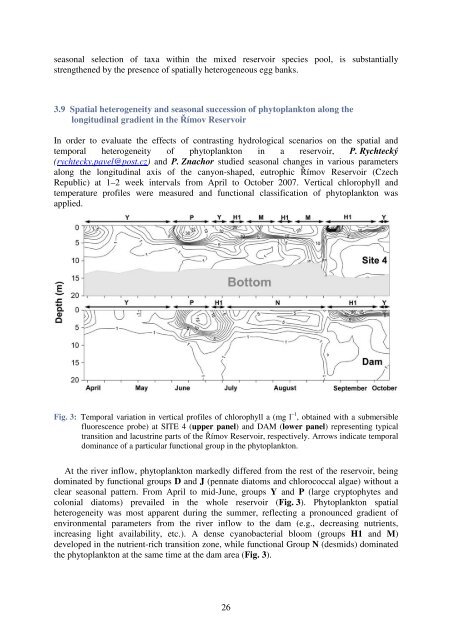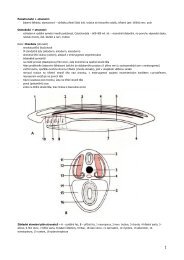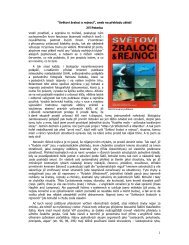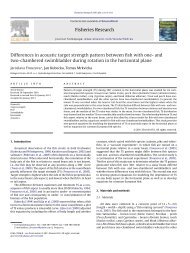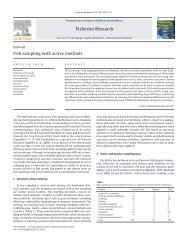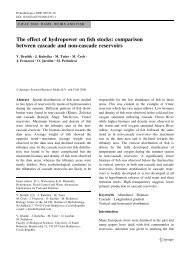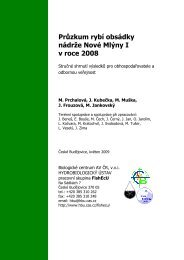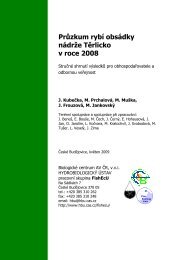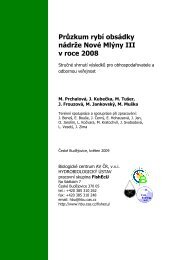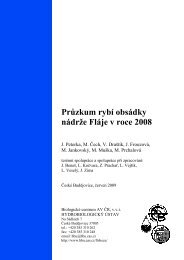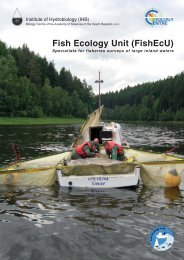anglicky - Institute of Hydrobiology
anglicky - Institute of Hydrobiology
anglicky - Institute of Hydrobiology
Create successful ePaper yourself
Turn your PDF publications into a flip-book with our unique Google optimized e-Paper software.
seasonal selection <strong>of</strong> taxa within the mixed reservoir species pool, is substantially<br />
strengthened by the presence <strong>of</strong> spatially heterogeneous egg banks.<br />
3.9 Spatial heterogeneity and seasonal succession <strong>of</strong> phytoplankton along the<br />
longitudinal gradient in the Římov Reservoir<br />
In order to evaluate the effects <strong>of</strong> contrasting hydrological scenarios on the spatial and<br />
temporal heterogeneity <strong>of</strong> phytoplankton in a reservoir, P. Rychtecký<br />
(rychtecky.pavel@post.cz) and P. Znachor studied seasonal changes in various parameters<br />
along the longitudinal axis <strong>of</strong> the canyon-shaped, eutrophic Římov Reservoir (Czech<br />
Republic) at 1–2 week intervals from April to October 2007. Vertical chlorophyll and<br />
temperature pr<strong>of</strong>iles were measured and functional classification <strong>of</strong> phytoplankton was<br />
applied.<br />
Fig. 3: Temporal variation in vertical pr<strong>of</strong>iles <strong>of</strong> chlorophyll a (mg l –1 , obtained with a submersible<br />
fluorescence probe) at SITE 4 (upper panel) and DAM (lower panel) representing typical<br />
transition and lacustrine parts <strong>of</strong> the Římov Reservoir, respectively. Arrows indicate temporal<br />
dominance <strong>of</strong> a particular functional group in the phytoplankton.<br />
At the river inflow, phytoplankton markedly differed from the rest <strong>of</strong> the reservoir, being<br />
dominated by functional groups D and J (pennate diatoms and chlorococcal algae) without a<br />
clear seasonal pattern. From April to mid-June, groups Y and P (large cryptophytes and<br />
colonial diatoms) prevailed in the whole reservoir (Fig. 3). Phytoplankton spatial<br />
heterogeneity was most apparent during the summer, reflecting a pronounced gradient <strong>of</strong><br />
environmental parameters from the river inflow to the dam (e.g., decreasing nutrients,<br />
increasing light availability, etc.). A dense cyanobacterial bloom (groups H1 and M)<br />
developed in the nutrient-rich transition zone, while functional Group N (desmids) dominated<br />
the phytoplankton at the same time at the dam area (Fig. 3).<br />
26


